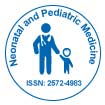Perinatal Biomarkers: Advancing Maternal and Neonatal Health
Received: 03-Feb-2025 / Manuscript No. nnp-25-171023 / Editor assigned: 06-Feb-2025 / PreQC No. nnp-25-171023 / Reviewed: 18-Feb-2025 / QC No. nnp-25-171023 / Revised: 22-Feb-2025 / Manuscript No. nnp-25-171023 / Published Date: 28-Feb-2025 DOI: 10.4172/2572-4983.1000508
Introduction
Perinatal biomarkers are biological indicators that provide crucial information about the health of a mother and her baby during the perinatal period, which spans from the 20th week of gestation to the first week after birth. These biomarkers, detectable in blood, urine, amniotic fluid, or other body tissues, can help identify complications, monitor fetal development, and predict adverse outcomes. In recent years, research on perinatal biomarkers has gained significant attention due to their potential to improve early diagnosis, guide interventions, and enhance both maternal and neonatal outcomes [1], [2].
Discussion
Perinatal biomarkers serve multiple purposes in obstetrics and neonatology. They can indicate maternal conditions such as preeclampsia, gestational diabetes, infections, or inflammatory responses that may affect the fetus. For the fetus and newborn, biomarkers can reveal growth restriction, hypoxia, organ immaturity, or metabolic abnormalities. Early detection through these biomarkers allows healthcare providers to implement timely interventions, potentially preventing severe complications or mortality [3]-[6].
Examples of commonly studied perinatal biomarkers include placental growth factor (PlGF) and soluble fms-like tyrosine kinase-1 (sFlt-1), which are associated with preeclampsia. Elevated sFlt-1 and low PlGF levels can signal the risk of this condition, enabling early monitoring and treatment. C-reactive protein (CRP) and interleukin-6 (IL-6) are inflammatory biomarkers that may indicate maternal or neonatal infection. Biomarkers such as fetal fibronectin help predict preterm labor, while brain-derived neurotrophic factor (BDNF) and other neurotrophic markers can provide insight into fetal brain development and the risk of neurological disorders [7], [8].
The use of perinatal biomarkers has several advantages. They offer a minimally invasive approach to assessing health status, often requiring only small blood samples or body fluids. They allow for early risk stratification, helping clinicians prioritize high-risk pregnancies and tailor interventions. Moreover, biomarkers contribute to research on maternal-fetal medicine by improving the understanding of disease mechanisms, enhancing prenatal screening programs, and guiding the development of therapeutic strategies [9], [10].
However, the application of perinatal biomarkers also presents challenges. Variability in biomarker levels due to maternal age, genetics, lifestyle, or gestational age can complicate interpretation. Standardization of measurement techniques and establishing reference ranges are critical to ensure accurate diagnosis and clinical relevance. Additionally, ethical considerations, cost, and accessibility may limit widespread adoption, particularly in low-resource settings.
Conclusion
Perinatal biomarkers play a vital role in modern obstetrics and neonatology, offering valuable insights into maternal and fetal health. By enabling early detection of complications such as preeclampsia, preterm labor, and neonatal infections, these biomarkers support timely intervention and improved outcomes. While challenges remain in standardization, accessibility, and interpretation, ongoing research continues to expand their potential applications. As technology advances and our understanding of maternal-fetal biology grows, perinatal biomarkers are poised to become an essential tool in personalized prenatal care, ultimately contributing to healthier mothers and babies worldwide.
References
- Shilpi M, Kumar K S, Kumar D (2020) Ayurvedic Approach Of Treatment Of Recurrent/ Chronic Cough In Children With Special Reference To Pancha Vidha Kasa. Ind J of App Res 10: 51-52.
- Nelaturi P, Nagarajan P, Sabapathy SK, Sambandam R (2021) Swarna Bindu Prashana—an Ancient Approach to Improve the Infant’s Immunity. Bio Tra Ele Res 199: 2145-2148.
- Sonune VG, Bhagile JB (2021) Use of Swarna Bindu Prashan in Children. IJRAMT 2: 215-217.
- Dutt SB, Jayant N (2016) A review article on Swarna prashana samskara wsr immunization. IJAA 2: 1024-1028.
- Shahapure S (2018) A Study On Parent’s Opinion Towards Swarna Bindu Prashana In Kalaburagi City. IJPERA 3: 1-4.
- Rao NP, Shailaja U, Mallika KJ, Desai SS, Debnath P (2012) Traditional Use Of Swarnamrita Prashana As A Preventive Measure: Evidence Based Observational Study In Children. IJRiAP 3: 1-5.
- Aniket P, Pallavi D, Aziz A, Avinash K, Vikas S (2017) Clinical effect of suvarna bindu prashan. JAIMS 2: 11-18.
- Gaikwad A (2011) A Comparative pharmaco-clinical study of Madhu-Ghrita and SwarnaVacha Madhu-Ghrita on neonates. Ayurved MD Research thesis. Jamnagar IPG T and R. A Gujarat Ayurveda University.
- Singh (2016) A Randomized Controlled Clinical Trial on Swarna Prashana and its Immunomodulatory Activity in Neonates. Jamnagar
- Rathi R, Rathi B (2017) Efficacy of Suvarnaprashan in Preterm infants-A Comparative Pilot study Journal of Indian System of Medicine 5: 91.
Citation: Tanvir R (2025) Perinatal Biomarkers: Advancing Maternal and Neonatal Health. Neonat Pediatr Med 11: 508. DOI: 10.4172/2572-4983.1000508
Copyright: © 2025 Tanvir R. This is an open-access article distributed under the terms of the Creative Commons Attribution License, which permits unrestricted use, distribution, and reproduction in any medium, provided the original author and source are credited.
Select your language of interest to view the total content in your interested language
Share This Article
Recommended Journals
Open Access Journals
Article Tools
Article Usage
- Total views: 57
- [From(publication date): 0-0 - Oct 11, 2025]
- Breakdown by view type
- HTML page views: 36
- PDF downloads: 21
